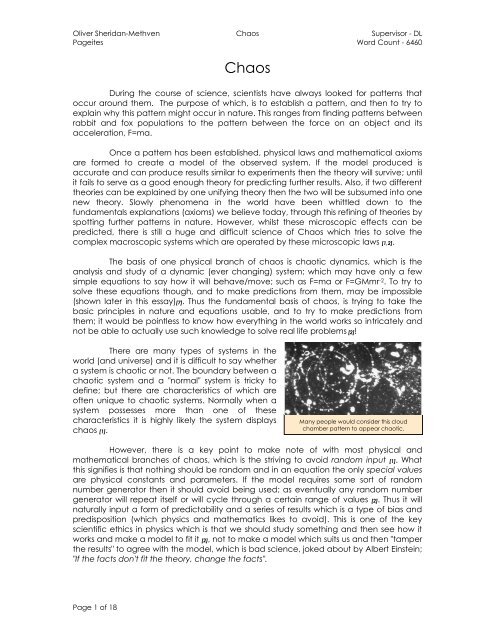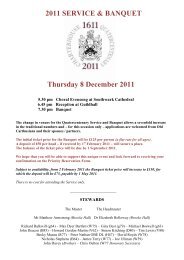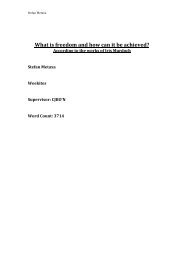Oliver Sheridan-Methven | PDF - Charterhouse
Oliver Sheridan-Methven | PDF - Charterhouse
Oliver Sheridan-Methven | PDF - Charterhouse
You also want an ePaper? Increase the reach of your titles
YUMPU automatically turns print PDFs into web optimized ePapers that Google loves.
<strong>Oliver</strong> <strong>Sheridan</strong>-<strong>Methven</strong> Chaos Supervisor - DL<br />
Pageites Word Count - 6460<br />
Chaos<br />
During the course of science, scientists have always looked for patterns that<br />
occur around them. The purpose of which, is to establish a pattern, and then to try to<br />
explain why this pattern might occur in nature. This ranges from finding patterns between<br />
rabbit and fox populations to the pattern between the force on an object and its<br />
acceleration, F=ma.<br />
Once a pattern has been established, physical laws and mathematical axioms<br />
are formed to create a model of the observed system. If the model produced is<br />
accurate and can produce results similar to experiments then the theory will survive; until<br />
it fails to serve as a good enough theory for predicting further results. Also, if two different<br />
theories can be explained by one unifying theory then the two will be subsumed into one<br />
new theory. Slowly phenomena in the world have been whittled down to the<br />
fundamentals explanations (axioms) we believe today, through this refining of theories by<br />
spotting further patterns in nature. However, whilst these microscopic effects can be<br />
predicted, there is still a huge and difficult science of Chaos which tries to solve the<br />
complex macroscopic systems which are operated by these microscopic laws [1,2].<br />
The basis of one physical branch of chaos is chaotic dynamics, which is the<br />
analysis and study of a dynamic (ever changing) system; which may have only a few<br />
simple equations to say how it will behave/move; such as F=ma or F=GMmr -2 . To try to<br />
solve these equations though, and to make predictions from them, may be impossible<br />
(shown later in this essay)[7]. Thus the fundamental basis of chaos, is trying to take the<br />
basic principles in nature and equations usable, and to try to make predictions from<br />
them; it would be pointless to know how everything in the world works so intricately and<br />
not be able to actually use such knowledge to solve real life problems [2]!<br />
There are many types of systems in the<br />
world (and universe) and it is difficult to say whether<br />
a system is chaotic or not. The boundary between a<br />
chaotic system and a "normal" system is tricky to<br />
define; but there are characteristics of which are<br />
often unique to chaotic systems. Normally when a<br />
system possesses more than one of these<br />
characteristics it is highly likely the system displays<br />
chaos [1].<br />
Many people would consider this cloud<br />
chamber pattern to appear chaotic.<br />
However, there is a key point to make note of with most physical and<br />
mathematical branches of chaos, which is the striving to avoid random input [1]. What<br />
this signifies is that nothing should be random and in an equation the only special values<br />
are physical constants and parameters. If the model requires some sort of random<br />
number generator then it should avoid being used; as eventually any random number<br />
generator will repeat itself or will cycle through a certain range of values [2]. Thus it will<br />
naturally input a form of predictability and a series of results which is a type of bias and<br />
predisposition (which physics and mathematics likes to avoid). This is one of the key<br />
scientific ethics in physics which is that we should study something and then see how it<br />
works and make a model to fit it [2], not to make a model which suits us and then "tamper<br />
the results" to agree with the model, which is bad science, joked about by Albert Einstein;<br />
"If the facts don't fit the theory, change the facts".<br />
Page 1 of 18
<strong>Oliver</strong> <strong>Sheridan</strong>-<strong>Methven</strong> Chaos Supervisor - DL<br />
Pageites Word Count - 6460<br />
What we might consider to be a normal system to be like then, would be one<br />
where we could reasonably easily work out, either logically or mathematically, what<br />
state the system has been in, and will be in, after some period of time. Thus given the<br />
conditions at the start we could accurately predict what it will look like at a later point in<br />
time. However, this "forecasting" is only a small branch of physics, pointed out by Richard<br />
Feynman; "Physics like to think that all you have to do is say, these are the conditions,<br />
now what happens next". However, a chaotic system can be extremely difficult or even<br />
impossible to predict well [1,2,3], such as the three body problem (explained later). Thus a<br />
property of a chaotic system is the issue with predictability; if it is difficult to predict or<br />
approximate what a later state will look like, then the system may be chaotic.<br />
This property of unpredictability can be caused by either/all of these three<br />
qualities of the system:<br />
A. Sensitive dependence<br />
B. Feedback loops<br />
C. Unsolvable equations [1,3,7,8]<br />
The last of these, C, is the simplest one; if the equations which are used to<br />
describe how the system behaves cannot be solved to give an exact solution (e.g. most<br />
nonlinear differential equations) then it may be impossible to calculate what will happen.<br />
Most often though, to resolve this problem, approximations are made to make the<br />
equations simpler; so the equations might then merge together to provide a solution.<br />
Although the result it is not 100% correct it may be a good estimate. However, if this<br />
"guessing" needs to be repeated many times to extend the prediction further into the<br />
future, slowly the answer will become increasingly more unreliable [1,9].<br />
The quality of sensitive dependence, A, is an issue not of the model's equations<br />
but rather of the data put into the model. Sensitive dependence arises with the<br />
uncertainty and error in a recorded value. If some data is input then a result is produced,<br />
however, as no data is 100% accurate [9], it is most likely a little bit off. Thus when a value<br />
is put in a range of values should be calculated, from the lowest possible value to the<br />
highest to give the spectrum of possible outcomes taking into account how wrong your<br />
measurements and data could be [9]. With many systems a little change in the data<br />
results in a little change in the result which is proportional to the error. This is the case of<br />
linear systems [3]. However, nonlinear systems are harder to work with because a little<br />
change in the data can result in a huge change in the outcome. Thus if there is a little<br />
error in the data there could be a huge variation in the results (technically quantified by<br />
Lyapunov exponents), thus if the data is not to a sufficient accuracy, the model could be<br />
unusable for making predictions [1]. James Gleick made the analogy to a pebble in a<br />
bowl and a pencil on a table. With the pebble in the bowl, if the pebble is in the bottom<br />
of the bowl then it will stay in the bottom, and if the data is wrong and the pebble is said<br />
to be an inch from the bottom then it will soon roll and settle into the bottom of the bowl<br />
and thus the system is not sensitive to it's initial conditions and it would be accurate for<br />
making predictions as to where the pebble will be. However,<br />
if you're trying to balance a pencil upright on its tip, then a<br />
tiny inaccuracy in the position of the top of the pencil can<br />
give many different results, and so this model will not be<br />
reliable for making predictions due to its sensitivity on data<br />
accuracy; which is an example of sensitive dependence [2].<br />
This is one of the reasons why it is easy to stay balanced<br />
sitting a bath but difficult to walk on a tight rope!<br />
Page 2 of 18
<strong>Oliver</strong> <strong>Sheridan</strong>-<strong>Methven</strong> Chaos Supervisor - DL<br />
Pageites Word Count - 6460<br />
The final feature of a feedback loop in a system, B, is often found hand in hand<br />
with sensitive dependence; commonly seen as two sides of the same coin. However,<br />
there are subtle differences between the two which are quite important. A feedback<br />
loop is often associated with an iterative solution to a problem, which might be forced by<br />
C. Thus if an error is present then it will still be present in the answer. The following state of<br />
the system is dictated by the previous state of the system when using iteration and so any<br />
uncertainty will be translated through the iterative feedback loop. Dependent on the<br />
system this can then be the cause of A but the fact that A is present doesn't imply that B<br />
is [1]. Thus B almost always forces A to occur, but A being present doesn't mean that B is<br />
(Figure1).<br />
Sensitive<br />
Dependence<br />
Figure1<br />
Normally Produces<br />
Sometimes Contains<br />
Feedback<br />
Loops<br />
The simplest system created which displays all of these characteristics was first<br />
discovered in biology and later analysed mathematically. This is the logistics map and<br />
was used initially to model a population of animals. What must happen is that the<br />
population must increase over time when it is small, so the first term was put in:<br />
F(X1) = λX0<br />
What this does is it increases the previous year's population, X0, by a fixed ratio,<br />
λ, to give the next years population, X1. However, this means that after enough time the<br />
population will become effectively infinite and bigger than it could possibly be. Thus a<br />
correctional term is introduced to bring down the population when it gets big and to<br />
boost it when it is small. NB the state of the population is between 0-1 for simplicity [1,2,3].<br />
F(X1) = λX0(1-X0) Ξ λ(-X0 2 + X0)<br />
Thus if this feedback loop is iterated (Figure2) then it should hopefully settle into<br />
a stable population. NB as this population represents the state of the system, this<br />
forecasting function can be used in other systems in maths, physics etc. However, when<br />
this is done over a range of values for λ then whilst it appears there may be stability in low<br />
values, past a certain point it will split into repeating solutions. This means that the system<br />
is oscillating between two states in a regular cycle which is reasonable. However, this<br />
splitting (birefringence) can occur again and again as λ increase until suddenly there is<br />
no order in the answers and there is a chaotic system! How this chaos mathematically<br />
arises is symbolically shown by the iterative process beside the logistics map in Figure2 [7].<br />
Page 3 of 18
<strong>Oliver</strong> <strong>Sheridan</strong>-<strong>Methven</strong> Chaos Supervisor - DL<br />
Pageites Word Count - 6460<br />
X 唴<br />
_<br />
F(X 1 ) = λ(-X 0<br />
2 + X 0 )<br />
Figure2<br />
λ<br />
What the logistics map symbolises for chaotic dynamics is the fact that in some of<br />
even the most simple systems; which can have just two or three factors effecting it,<br />
where one of these factors is adjustable, then it can be adjusted to produce any of three<br />
system states. First of these states is the state where nothing is happening and any initial<br />
state will soon settle into a fixed state. The second is where the system will fall into an<br />
active steady state where it will either be doing a fixed motion or will be cycling through<br />
states regularly (demonstrated in a later experiment). The final implication of the logistics<br />
map is that if the correct parameter (λ) is chosen, then the system will be unpredictable<br />
and will fall into a system of chaos that will appear to have no pattern and therefore<br />
looks random [2,7].<br />
When a system appears random the challenge is to then spot some sort of<br />
underlying pattern or trend; and to manipulate the data until such a pattern (and thus<br />
predictability) arises. Whilst many chaotic systems may not have an underlying pattern, a<br />
significant amount does. The task is to first find any strange attractors; which are points or<br />
trajectories through phase space. Phase space is just a graph of how the system is<br />
behaving as time goes by (Figure3) and where a certain point represents a<br />
characteristic, such as velocity or angle or potential energy etc. Thus one point could<br />
represent a system having a lot of kinetic energy when it is at such an angle whilst<br />
another point signifies another state the system can be in such as low kinetic energy but<br />
high temperature [1,2,3]. Thus if all paths through phase space always end up reaching a<br />
certain point then that point is a strange attractor. Similarly if a path continues orbiting a<br />
point in a circle for example, then the centre is a strange attractor. Finally, if all paths<br />
converge eventually into a certain path/trajectory (be it a straight line or a bizarrely<br />
shaped curve as in Figure3), even if initially off that path, then that trajectory is known as<br />
a strange attractor.<br />
Page 4 of 18
<strong>Oliver</strong> <strong>Sheridan</strong>-<strong>Methven</strong> Chaos Supervisor - DL<br />
Pageites Word Count - 6460<br />
Figure3<br />
Strange Attractors<br />
Figure3 shows how the measurements of a system and how it is behaving over<br />
time (top row); e.g. velocity with time, translate into phase space diagrams (bottom row)<br />
of height with gradient. Here it is evident that where the top row may be unclear in<br />
displaying how the system is behaving and what it will do with time (most prominent in<br />
the top right plot), when transformed into a phase space diagram it can become<br />
apparent what the system is doing. Thus apparent randomness, in what appears to be a<br />
chaotic system, can be translated into predictability in phase space, allowing for a<br />
chaotic system to be made predictable [1,3].<br />
The idea of there being underlying patterns in phase<br />
space which produce predictability, seems counterintuitive for<br />
chaotic systems. The fact that "randomness" can have patterns<br />
seems slightly illogical (and to an extent impossible) and thus<br />
an experiment was conducted to try to demonstrate this<br />
concept with real data collected from the lab, and not<br />
produced from theory. A very basic system encountered<br />
which was unexpectedly chaotic was that of the pendulum.<br />
For an equivalent James Gleick used the image of a child on a<br />
swing, which will be extended upon in the explanation of the<br />
experiment.<br />
If a child is on a swing and the swing is not moving<br />
then as time goes by the child will stay on the swing in the<br />
same position, which is obvious. If a child is then pushed once<br />
in the swing then they will oscillate to and from the same<br />
height, just at different angles on the swing (demonstrating the<br />
conservation of energy). Finally if friction is acknowledged then<br />
eventually the energy will dissipate from the system and the<br />
child will eventually come to a halt in the bottom of the swing<br />
position again. When these three processes are plotted in<br />
phase space (Figure4) it is much clearer to see the behaviour<br />
of the system and to spot the strange attractors in the system.<br />
NB even though the system is not yet chaotic, it has strange<br />
attractors in phase space [2].<br />
In the frictionless system the swing will carry on<br />
swinging and the phase space will form a loop (Fiugre4) which<br />
Strange Attractors<br />
Figure4<br />
Page 5 of 18
<strong>Oliver</strong> <strong>Sheridan</strong>-<strong>Methven</strong> Chaos Supervisor - DL<br />
Pageites Word Count - 6460<br />
demonstrates that after a certain period of time it will reach the same state. As it is then<br />
identical in state to how it was previously, it will follow the same course of action, and<br />
thus if a loop is formed it will continue in that loop forever. Equally, with the swing that has<br />
friction, it must eventually settle down to a fixed point which is when the swing has<br />
stopped [2] and so the phase space trajectory will always collapse into the origin<br />
(Fiugre13).<br />
However, a simple modification can be made to this system which quite<br />
unexpectedly introduces chaotic properties. This is to introduce a regular pushing force,<br />
such as a periodic torque on the swing. At first glance, this would seem just as regular as<br />
before, only just slightly more complicated mathematically. When a child is swinging,<br />
every time they reach the top of their return swing, they pull on the swing's rope (doing<br />
work on it and adding energy to the swing system) so that they stay in a regular swinging<br />
motion; where's the chaos in that? However, this is not a continuous and regular force;<br />
these are discrete and well timed packets of energy input specifically chosen for that<br />
frequency of swinging [2]. If the child were to do just the same rhythm of tugging on the<br />
rope on a longer swing, then they would pull at the wrong time, cause a jerk in the<br />
swing's motion, either speed up or slow down too quickly and would fall off. As will be<br />
shown later by the experiment, they may also swing through a full rotation and then<br />
suddenly stop at the bottom, which would certainly cause any child injury.<br />
Upon a technical analysis of what happens, is that although the pattern of<br />
forces applied may be in equilibrium, only some of the time, will this result in a system<br />
which is in equilibrium. This unexpected point was noted by James Gleick; "Even when a<br />
dampened, driven system is at equilibrium, it is not at equilibrium". This is due to the non<br />
linear relationship between the forces as time goes by [2,5]. The flow of energy in and<br />
energy out of the system has non linear equations, because the frictional torque is<br />
derived from the angular velocity, which changes with the angle of the swing as it goes<br />
from the bottom to the top of its arc. This is an example of how the system has a<br />
feedback loop and as we will see from the later experimental results, sensitive<br />
dependence.<br />
ΣT<br />
Φ<br />
L<br />
m<br />
Figure5<br />
m<br />
ω<br />
T 1 ,T 2 ,T 3<br />
The setup for the experiment was as follows<br />
(Figure5) [5]:<br />
For the experiment (in theory) there should be<br />
three sources of torque acting on the pendulum; T1, T2, T3<br />
[5]. The first is the torque from gravity which would<br />
produce simple harmonic motion (approximately for δΦ)<br />
provided it was the only force acting on the pendulum.<br />
The second is the torque due to friction which always<br />
works against the direction of the angular velocity. The<br />
final is the torque due to the driving force (child pulling<br />
on the swing's rope) adding torque in a periodic<br />
manner.<br />
Mathematically, these torques are given by:<br />
o T1 = -LmgSin(Φ)*<br />
o T2 = -kω †<br />
Commonly approximated to –LmgΦ to produce SHM<br />
Where k is a parameter value to determine the strength of<br />
the frictional torque<br />
Page 6 of 18
<strong>Oliver</strong> <strong>Sheridan</strong>-<strong>Methven</strong> Chaos Supervisor - DL<br />
Pageites Word Count - 6460<br />
o T3 = ASin(λt)<br />
This provides an external periodic torque on the system<br />
NB *the negative values denote for the first torque that it always acts to bring<br />
the pendulum back to the rest position, against the orientation of Φ, and is inwards<br />
acting. † The second negative torque signifies that the friction always acts in the<br />
orientation opposing the angular velocity of the pendulum.<br />
Thus by the laws of rotational motion where:<br />
Iα = ΣT as I = mL 2<br />
mL 2 α = T1 + T2 + T3<br />
mL 2 α = -LmgSin(Φ) –kω + ASin(λt) [5]<br />
α = -gL -1 Sin(Φ) + (-kω + ASin(λt))m -1 L -2 [7] as ω = Φ' and α = Φ''<br />
Φ'' = -gL -1 Sin(Φ) + (-kΦ' + ASin(λt))m -1 L -2<br />
The problem with these equations is that they cannot be solves explicitly to find<br />
the solution for Φ [7,8]. Thus there is no general solution for the angle with time, and<br />
therefore it is unpredictable with regards to a mathematically exact solution. This is due<br />
to the equation being a second and first order differential equation, which is nonlinear [8].<br />
This can only be approximated, to guess a solution for a value of time, by performing an<br />
iterative approximation over δt periods. This will act to guess the position quite well, but as<br />
time goes by the guess will eventually become evermore unreliable. This demonstrates<br />
how this system is mathematically chaotic. In reality though, does it actually behave<br />
chaotically? The aim of the experiment was to discover if any strange attractors appear<br />
after analysis of the data; and whether this system of unsolvable equations produces<br />
reliability. The question is whether from the chaotic equations a regular system can be<br />
found?<br />
The experiment was aimed to resemble the computer simulation provided by<br />
source [5] as closely as possible (Figure6). There were initial problems with methods of<br />
recording the position of the end of the pendulum with the corresponding time by use of<br />
video tracking due to the speed of the pendulum. This was resolved with a device with a<br />
protruding axle which was attached to the pivot of the pendulum. The device has a<br />
relatively much lower rotational friction compared to the driving force device (motor) of<br />
the pendulum. Thus whilst this setup was not ideal, as the added friction was relatively<br />
minor effect, it could be neglected. The driving torque was provided by an electrical<br />
motor powered by a signal generator giving out an AC produced by a varying voltage<br />
which followed a sine wave. This produced a varying torque which exactly matched T3.<br />
NB this was verified by the cathode ray oscilloscope during the experiment.<br />
Page 7 of 18
<strong>Oliver</strong> <strong>Sheridan</strong>-<strong>Methven</strong> Chaos Supervisor - DL<br />
Pageites Word Count - 6460<br />
Figure6<br />
The CRO (above) verified the voltage<br />
acting on the pendulum was a sine<br />
wave and that the signal generator<br />
(below) caused an AC through the<br />
motor.<br />
The motor here provided the driving<br />
torque to act on the pendulum. The<br />
nuts and bolts at the end<br />
approximate a pendulum as closely<br />
as possible.<br />
The blue device records the angle of<br />
the pendulum with time and has a<br />
very low frictional torque. The axes<br />
were joined together by the tube<br />
device at the top of the pendulum.<br />
NB – Whilst the essential principles for the pendulum were from [5], the experiment was designed entirely by myself.<br />
However, the experiment’s setup was constructed with the aid of the <strong>Charterhouse</strong>’s Physics technicians. Yet, all data was<br />
collected and analysed by myself.<br />
M<br />
CRO<br />
A<br />
C<br />
m<br />
Output data of angle v s<br />
time<br />
Φ vs t<br />
The pendulum was approximated as closely as it could by a light metal rigid<br />
rod. A mass of two large metal washers was bolted onto the end of the pendulum so that<br />
the bulk of the mass was at the end of the rod (approximating a pendulum). When the<br />
signal generator was switched on the data was then recorded into "data studio", and<br />
then moved to Microsoft Office Excel (Figure7).<br />
Figure7<br />
Page 8 of 18
<strong>Oliver</strong> <strong>Sheridan</strong>-<strong>Methven</strong> Chaos Supervisor - DL<br />
Pageites Word Count - 6460<br />
The parameters of the experiment were:<br />
o The amplitude of the voltage from the signal generator and thus the<br />
maximum torque which could be driven into the pendulum.<br />
o The length and mass of the pendulum.<br />
o The frequency of the signal generator and thus how frequently the driving<br />
torque changes direction.<br />
Since the aim was to determine the nature of how birefringence from stable to<br />
chaotic might occur within the system due to the variation of just one of the parameters,<br />
two of the parameters were forces into set values. The only parameter which could be<br />
accurately changed through a relatively large range of values was the signal frequency,<br />
thus the others were kept at constant values during the collection of data. The signal<br />
amplitude was maintained at 5.6V + 0.1V and the length of the pendulum was always<br />
0.14m, which did not change during experiments, however, the error in this length was<br />
+0.003m.<br />
One of the preliminary experiments was to determine the nature of friction in<br />
the setup. Whether the frictional torque was a first, second, or even zero order<br />
polynomial function of the angular velocity. To discover this, a large blob of putty was<br />
formed into a ball around the axis, before all the data was collected, and was spun up<br />
to a very fast angular velocity (c200 rad/s), by a separate power supply. Then the power<br />
was disconnected and the observed angular deceleration was recorded (Figure8).<br />
Figure8<br />
Page 9 of 18
<strong>Oliver</strong> <strong>Sheridan</strong>-<strong>Methven</strong> Chaos Supervisor - DL<br />
Pageites Word Count - 6460<br />
The significance of the straight line in Figure8 during the deceleration period<br />
shows that the frictional torque acting on the system acted on a zero order polynomial<br />
function of the angular velocity. What this meant was that there was an invariant<br />
(constant) frictional torque acting on the pendulum whenever it was in movement.<br />
Once this preliminary was conducted, the experimental data could be<br />
collected (Figure7). This was done over a set of values for the signal frequency from<br />
1.01Hz – 1.31Hz +0.01Hz. A typical spread sheet of data would contain a table of the<br />
initial conditions, the time, angle, angular velocity and a corrected angle. The corrected<br />
angle was a manipulation of the recorded angle; to transform it such that if the<br />
pendulum has rotated through 360 0 (2π c ) although the angles are recorded differently,<br />
then this new corrected angle would take the same value when the pendulum was in<br />
the same position. The reason for this should become clear after the analysis has been<br />
performed and the phase space trajectories plotted.<br />
Then a data set of the<br />
recorded angle against time was<br />
taken (Figure9) which could show<br />
how much the pendulum had<br />
rotated during the course of the<br />
data collection. What this shows is<br />
that during the blue run the<br />
pendulum had no preferred<br />
rotation, whilst in the purple run,<br />
the pendulum tended to<br />
repeatedly rotate through a full<br />
anticlockwise turn. This<br />
demonstrates how although all the<br />
conditions can appear the same to a<br />
high degree of accuracy, the results<br />
can soon diverge (Figure10), due to<br />
the sensitive feedback system which<br />
this proves to be.<br />
Figure9<br />
Figure10<br />
This sensitive dependence in<br />
the experiment shows how tiny<br />
discrepancies in the accuracy can<br />
result in differing outcomes and<br />
behaviours. This is best displayed with<br />
the corrected angles plot with time<br />
(Figure11).<br />
Demonstration of how identical states can quickly diverge<br />
into different final states. This was a weather simulation by<br />
Lorenz using only a few simple equations but the feedback<br />
loops caused this sensitive dependence.<br />
In Figure11 the top graph traces how the repeat run, the purple run, during the<br />
first five seconds almost identically follows the behaviour of the first run, the blue run.<br />
What this demonstrates is how the conditions in the start were (to a very high accuracy)<br />
the same. However, the middle graph follows how the two runs behaved in the<br />
proceeding five seconds, and how the two behaviours were starting to separate, shown<br />
by the waves becoming ever increasingly out of phase. Very soon after this difference<br />
had set in, it is clear to see how these two now slightly differing runs quickly become<br />
incoherent with respect to the other. During the fifteenth to the twentieth second<br />
(bottom graph), the two runs were in two completely different states, the blue run is<br />
following the motion of a normal pendulum, swinging back and forth, whilst the purple<br />
Page 10 of 18
<strong>Oliver</strong> <strong>Sheridan</strong>-<strong>Methven</strong> Chaos Supervisor - DL<br />
Pageites Word Count - 6460<br />
run is swinging completely through a full rotation in a regular cycle. Thus although even<br />
the two runs had the same initial conditions, after a period of time (due to their sensitive<br />
dependence and feedback loops found in their equations) had settled into two different<br />
states/rhythms.<br />
0-5s<br />
5-10s<br />
Figure11<br />
15-20s<br />
There are ultimately three ways that the pendulum could behave (Figure12)<br />
depending on the frequency chose. If the frequency is too high then it will only cause a<br />
rapid and small vibration of the pendulum and overall this effect will cancel itself out,<br />
thus it will act approximately to a normal pendulum with friction and will come to a halt.<br />
This would cause an implicit trajectory through the phase space. This would also happen<br />
with a frequency that is too low, and then once the pendulum has settled into a<br />
stationary state the driving force would just tilt the pendulum slowly from side to side.<br />
Overall this would still produce an implicit trajectory. The second possibility, which is the<br />
most familiar to people, is to produce a symplectic trajectory. This would be where the<br />
frequency chosen would produce a regular oscillation, just as a child does on a swing to<br />
maintain reaching a constant height. In phase space this would form regular orbits and<br />
loops without touching the constraints (borders) of the phase space. The final possibility<br />
would be to produce an explicit<br />
trajectory where the pendulum would<br />
Figure12<br />
"randomly" gain speed and lose speed<br />
at certain points in the rotation. If a child<br />
were to do this on a swing then they<br />
would get higher and higher and<br />
possibly suddenly slow down at one<br />
point in the swing, then slow down to a<br />
stop again, giving a chaotic<br />
appearance when observed. Also they<br />
have the possibility of swinging over the<br />
top of the swing and then back round<br />
Explicit Implicit Symplectic<br />
Page 11 of 18
<strong>Oliver</strong> <strong>Sheridan</strong>-<strong>Methven</strong> Chaos Supervisor - DL<br />
Pageites Word Count - 6460<br />
again and then returning to a normal pendulum action. In phase space this would be<br />
when the trajectory travels off the boundary in the phase space and then would return<br />
on the other side of the phase space. This is where the angle of the child changes from<br />
positive to negative once he crosses over the top of the swing. The purpose of correcting<br />
the angles was technically so that when a point went off of one boundary/edge, the<br />
corrected angle would cause the point to appear on the opposite side of the phase<br />
space.<br />
The transition from one of these trajectories into another type would be a form<br />
of birefringence of the system. Thus a further and more detailed aim was to see whether<br />
adjusting the frequency of the experiment's signal could produce these results. The first<br />
was to choose a very high frequency; which as explained earlier would have no overall<br />
effect but vibration. Thus the frequency was set to an excessively high frequency and<br />
was manually raised to a perpendicular position (90 0 ). Then it was released and the<br />
motion plotted and the<br />
trajectory through phase space<br />
traced (Figure13).<br />
What Figure13 displays<br />
is how the pendulum went from<br />
perpendicular and slowly swung<br />
through the centre four times,<br />
each time slowing down and<br />
then becoming stationary.<br />
Through phase space it traced<br />
the implicit trajectory, under the<br />
influence of the strange attractor<br />
at the origin. Therefore by<br />
adjusting the frequency the<br />
trajectory could be predicted.<br />
Thus at this frequency the<br />
chaotic system was easily<br />
approximated to a predictable<br />
one. Then the aim was then to<br />
construct the other two types of<br />
trajectories; symplectic and<br />
explicit, by causing a<br />
birefringence of the states<br />
through the variation of the<br />
signal frequency.<br />
Figure13<br />
The proceeding experiments were the runs where the frequency of the signal<br />
significantly affected the behaviour of the pendulum (i.e. not implicit trajectories);<br />
causing what appeared to be erratic behaviour. The first frequency (Figure14) was<br />
1.01Hz (there was a constant error in all frequencies of +0.01Hz) which initial caused an<br />
explicit trajectory (top left), behaving chaotically, until at around twenty seconds, it<br />
settled into an implicit trajectory (bottom left), following a regular pendulum motion.<br />
Overall the transition from chaotic into regular is best displayed by the angle time graph<br />
(top right) and gives the two overall trajectories (symplectic and explicit) through phase<br />
space (bottom right).<br />
Page 12 of 18
<strong>Oliver</strong> <strong>Sheridan</strong>-<strong>Methven</strong> Chaos Supervisor - DL<br />
Pageites Word Count - 6460<br />
Explicit<br />
Symplectic<br />
Explicit<br />
Figure14<br />
Symplectic<br />
The significance of the pendulum having the capability of making the sudden<br />
transition from an explicit trajectory to a symplectic trajectory is that it is the<br />
manifestation of the feedback loop and the sensitive dependence. Where there was a<br />
feedback loop, the system was easily repeating the previous trajectory again and again.<br />
However, where it was a sensitive system, when the system diverged from this trajectory<br />
slightly, it was attracted by the strange attractor significantly enough to make the<br />
transition of trajectories into the symplectic trajectory. This demonstrates how tiny<br />
variations have the potential to cause large differences in states.<br />
Once this sensitivity within the system was established, the intension is to<br />
increase the frequency to find a birefringence of trajectories or a region of stability. At<br />
the frequencies around 1.14Hz (Figure15) the phase spaces began to have the majority<br />
of the trajectory following the explicit path and the minority having a symplectic form.<br />
Figure15<br />
Symplectic<br />
Explicit<br />
Page 13 of 18
<strong>Oliver</strong> <strong>Sheridan</strong>-<strong>Methven</strong> Chaos Supervisor - DL<br />
Pageites Word Count - 6460<br />
Similar results were obtained with increasing frequencies until 1.31Hz was used<br />
(Figure16). When this frequency was applied an extremely regular explicit trajectory was<br />
formed. The pendulum swung very periodically through a full rotation in the same<br />
orientation. This was performed in a period four motion of the pendulum, due to the<br />
unique frequency that was able to resonate the pendulum, such that it produced a very<br />
regular oscillation pattern.<br />
Figure16<br />
The resulting phase space diagram in Figure16 represents how from the previous<br />
phase spaces, which appeared chaotic and without well defined trajectories (Fig14&15),<br />
a well selected frequency could produce a stable state. This is demonstrated by the<br />
extremely well defined trajectory which has great clarity (bottom graph in Figure16),<br />
forming a closed loop (joined at the edges of the phase space). However, how does this<br />
regularity arise from the chaotic birefringence<br />
and from amid the surrounding chaos? This can Figure17<br />
be said to be a unique solution/frequency<br />
which could be the one specially chosen to<br />
repeat this circuit of rotation; the<br />
correspondingly lower frequency is the one<br />
commonly used by a child on a swing [2].<br />
However, from the logistics map which<br />
parallels this system, only the chaos arose. It<br />
didn't appear that there was any stability past<br />
the first onset of chaos. However, on further<br />
inspection there are streaks of stability<br />
(Figure17), emerging as clear lines amongst the<br />
black. These can correspond to frequencies<br />
which induce stability [1,2,3,7], such as 1.31Hz.<br />
These clear streaks represent the unique<br />
frequencies which can resonate the pendulum<br />
into a regular rhythm, such as 1.31Hz.<br />
Page 14 of 18
<strong>Oliver</strong> <strong>Sheridan</strong>-<strong>Methven</strong> Chaos Supervisor - DL<br />
Pageites Word Count - 6460<br />
Figure18<br />
Computer Simulation by [5]<br />
Experimental Results<br />
So upon comparison of the<br />
experimental results to the computer<br />
simulation (Figure18) it is evident that the<br />
simulations can demonstrate many of the<br />
aspects of that occur in reality within the<br />
system. However, it would be difficult<br />
(almost impossible) to determine, from<br />
the four simple equations which govern<br />
the torque and the angular acceleration,<br />
the nature of the phase space<br />
trajectories and the strange attractors<br />
present. Secondly, it has proved to be a<br />
high quality manifestation of the logistics<br />
map and its qualities of birefringence and<br />
isolated regions of stability (1.31Hz) in such<br />
a relatively simply governed system<br />
(T1,T2,T3).<br />
Ultimately, this experiment<br />
demonstrates the capabilities that<br />
strange attractors have: that a plot in<br />
phase space can reduce the system's<br />
apparent randomness and<br />
unpredictability into order and patterns. From these patterns predictability can be<br />
induced which is the ultimate aim in experimental science; combining microscopic<br />
equations into macroscopic predictions, and the knowledge of what will happen next [2].<br />
Throughout the history of physics and natural philosophy though, there has<br />
always been one topic that used to take precedence over all others. During the days<br />
when religion and science were intermingled, the stars and planets were of divine<br />
significance. The movement of the heavenly spheres (planets) and the study of<br />
astronomy were the professions of the educated few (natural philosophers,<br />
mathematicians and some members of the church). Beginning with the theory of a<br />
geocentric universe, this was changed by Nicolaus Copernicus, proposing the<br />
heliocentric model for calculations in his book, On the Revolution of Celestial Spheres.<br />
Following this Galileo Galilei more fully supported this idea until Johannes Kepler<br />
published in Harmony of the World the collected data which supported, to the point of<br />
proof, the heliocentric model. Finally the issue appeared to be settled definitively in Isaac<br />
Newton's Mathematical Principles of Natural Philosophy. This had proved to be the most<br />
problematic issue: predicting where the divine bodies will appear at a given time [4].<br />
The key to Newton's success in resolving the issue definitively was to take<br />
Galileo's concept of inertia and extend upon it with mathematical description. These are<br />
known as Newton's three laws of motion which describe how things move. The first two<br />
laws can be described just by the second law; that when a force acts on a body its<br />
velocity will change. This is mathematically described by:<br />
F = dPdt -1 =ma<br />
The third law says for every impulse (F◦t) there is an equal and oppositely<br />
directed impulse. This law was not crucial though in his solution for a heliocentric model.<br />
Page 15 of 18
<strong>Oliver</strong> <strong>Sheridan</strong>-<strong>Methven</strong> Chaos Supervisor - DL<br />
Pageites Word Count - 6460<br />
The ultimate key to the success of the Newtonian model was his first and second law and<br />
the knowledge of Kepler's laws of planetary motion. Newton used Kepler's third law to<br />
deduce his law of universal gravitation:<br />
F = -GMmr -2 the negative sign denotes the force is inwards acting [9].<br />
From these laws there have been many derivations of how the planets move,<br />
which vary from the geometric proofs demonstrated in Principia and Feynman's Lost<br />
Lecture to algebraic proofs, using complicated calculus, such as in Mechanics and<br />
Vectors by Terry Heard [4,7,10]. The results from all of these are that the planets move in<br />
ellipses around the sun, the eccentricity of which can vary immensely; earth travels in a<br />
nearly circular orbit whilst Halley's Comet travels in a very eccentric orbit. Not only does<br />
theory predict this, but simulations support this (Figure19) and observations confirm this to<br />
a reasonable degree of accuracy.<br />
Figure19<br />
Here are two computer simulations using only the equations F = ma and F = -GMmr -2 which generate very accurate<br />
orbits (left) for earth and various comets (right).<br />
The key to the success in the predictions of these equations and simulations was<br />
the nature in which they were analysed. During all of these solutions there are only two<br />
bodies/planets, never more than two. The importance of this is that at all points in the<br />
orbit there is only once source of the gravitation force acting on any one body, which is<br />
the one produced by the other body. The significance is that during the geometrical<br />
analysis that all changes in velocity (acceleration) are in towards the other body directly.<br />
During the algebraic analysis, this means that the acceleration's component vector<br />
which is perpendicular to the axis connecting the two planets (a2) is equal to zero<br />
(Figure20). This is the fundamental principle<br />
from which all other derivations about the<br />
a 2<br />
planet's motion are made possible [4,7,10].The Figure20<br />
problem when three or more bodies of<br />
considerable mass are present is that the<br />
a 2 = 0<br />
principle that only centripetal acceleration<br />
exists (only a1) is frequently incorrect (i.e. a2 ≠<br />
m<br />
0). Consequently then the geometric<br />
derivations and algebraic demonstrations<br />
a 1<br />
which relied on only a2 existing are reduced<br />
to false models [7].<br />
M<br />
Page 16 of 18
<strong>Oliver</strong> <strong>Sheridan</strong>-<strong>Methven</strong> Chaos Supervisor - DL<br />
Pageites Word Count - 6460<br />
The issue with a three or more body problem is that a new set of nonlinear<br />
equations are created, and a chaotic system is born (Figure20). Mathematically the<br />
equations are all unsolvable and can only be guessed by iterative functions (e.g. "the<br />
disturbing function"). However, normally with the huge masses, distances, velocities and<br />
forces involved, these models soon become unreliable. This unreliability is what induces<br />
the sensitive dependence within the system whilst the iterative process causes the<br />
feedback loops. This chaotic system is demonstrated by the simulation in Figure21,<br />
provided by source [6].<br />
Figure21<br />
No Strange Attractors Exist<br />
The significance of three body problems having no strange attractors over the<br />
vast range of situations is that the ability of astronomy to produce reliable predictions<br />
becomes effectively impossible. When three bodies are present they could settle into<br />
some dynamic orbit within each other (which is irregular); they could collide with each<br />
other catastrophically! There is even the possibility that they call all collapse into each<br />
other and fling out one of the planets with a speed faster than the relative escape<br />
velocity. This makes efforts to forecast how our solar system formed and how it will<br />
continue, fundamentally ineffective. The exact course of our solar system, and even<br />
universe, can never be determined as a whole. No grand underlying pattern can<br />
possibly emerge and thus the accurate nature of the solar system, its future and past, is<br />
indeterminable [7].<br />
Over the course of science, the purpose of investigation and experimentation<br />
has been to discover underlying patterns. From these trends, physical laws are produced<br />
in ever increasing accuracy. Our ability to forecast the most intricate events has grown in<br />
strength. However, whilst our knowledge of the microscopic world has grown, that of the<br />
macroscopic has reduced. With ever increasing knowledge of how systems behave on<br />
their own, it emerges that the giant mesh of systems that exist within the world form an<br />
ever decreasingly predictably structure. Chaos has proven that this is the case for even<br />
the most basic of systems such as the chaotic pendulum; extending through to<br />
historically the most philosophically important questions about the planets and their<br />
motions. This new and emerging science of chaos and chaotic dynamics has forced us<br />
to question the knowledge which we have traditionally believed to govern how things<br />
behave, finely summarised by James Gleick; "Knowledge of the fundamental equations<br />
no longer [seems] to be the right kind of knowledge at all".<br />
Page 17 of 18
<strong>Oliver</strong> <strong>Sheridan</strong>-<strong>Methven</strong> Chaos Supervisor - DL<br />
Pageites Word Count - 6460<br />
Sources:<br />
[1] Chaos: A Very Short Introduction, Leonard Smith<br />
[2] Chaos, James Gleick<br />
[3] Introducing Chaos, Ziauddin Sardar & Iwona Abrams<br />
[4] Feynman's Lost Lecture, David & Judith Goodstein<br />
[5] http://myphysicslab.com/pendulum2.html - Chaotic Pendulum<br />
14/04/2010<br />
[6] http://myphysicslab.com/molecule3.html - Three Body Problem<br />
14/04/2010<br />
[7] Discussions with Ivan Hoffman DeVisme (IDV)<br />
[8] Discussions with Edward Reid (EJR)<br />
[9] Discussions with Dean Johnson (DRHJ)<br />
[10] Mechanics and Vectors, Terry Heard<br />
Page 18 of 18
















